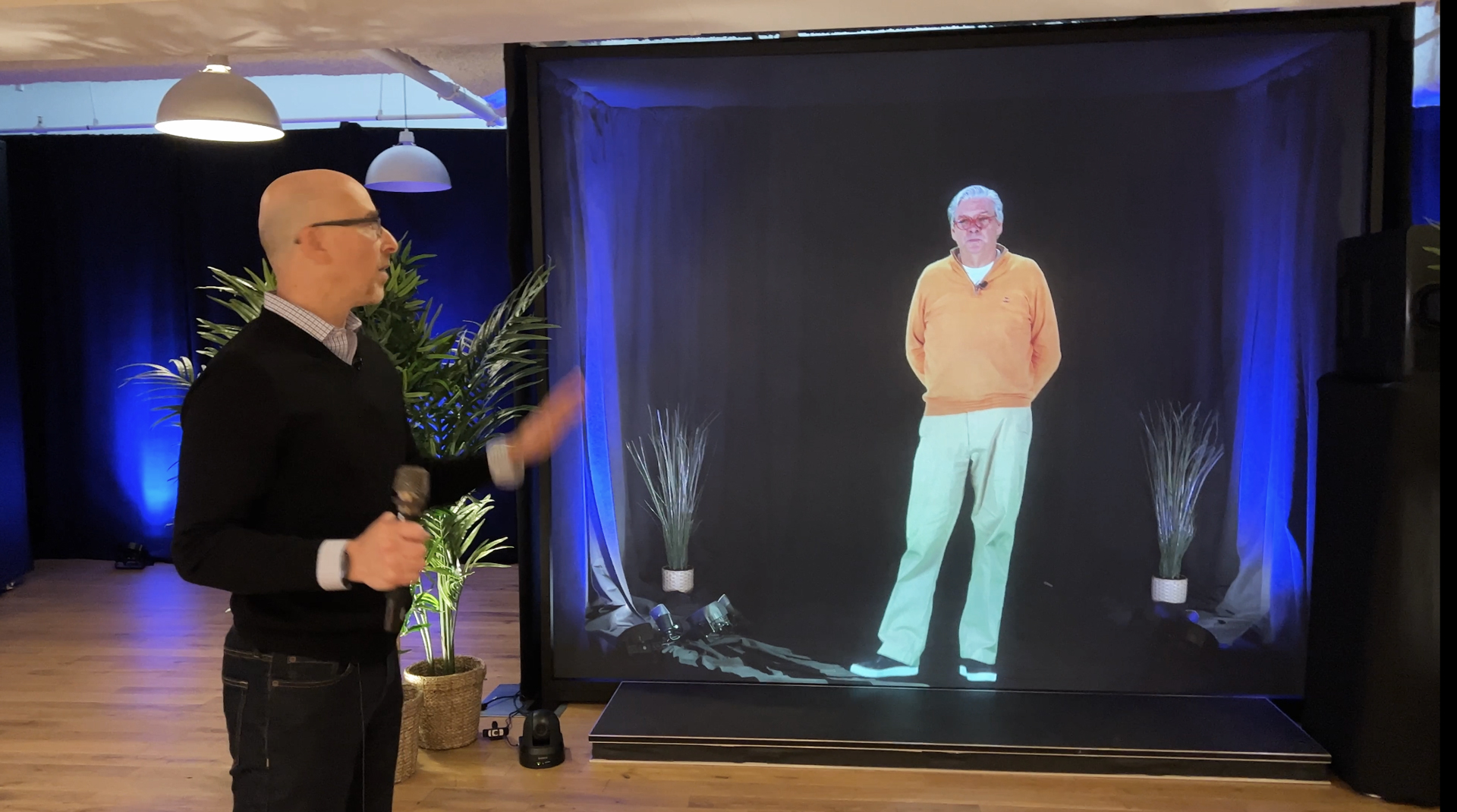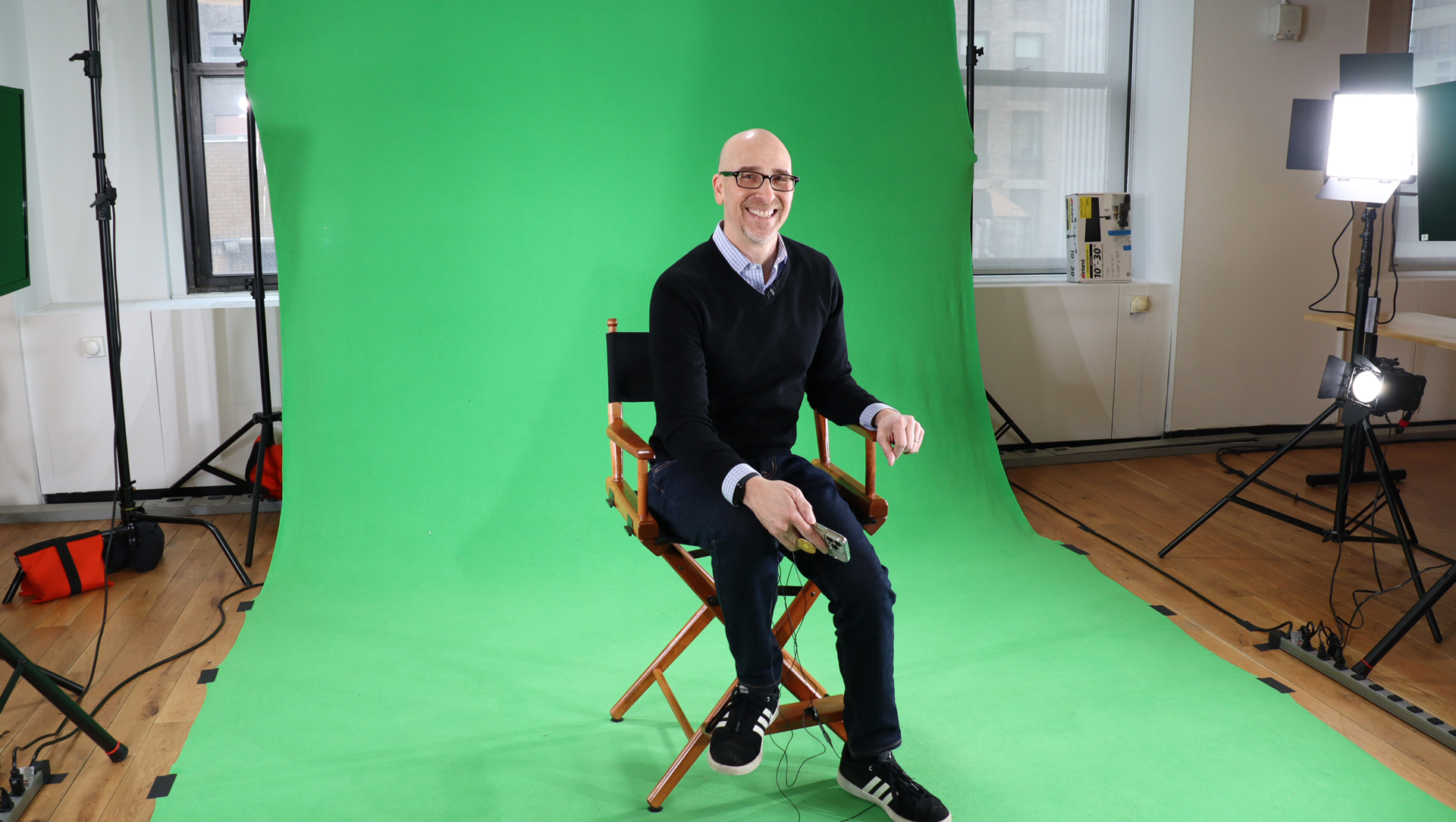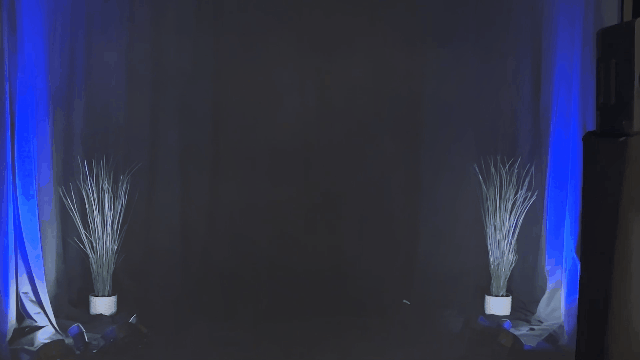Holopresence means never having to say, ‘Sorry, I can’t be there’
This is how I beamed in like 'Star Trek'

In Holopresence land you can be two places at once. One is sitting on a director’s chair in front of a green screen, sweating under a half dozen stage lights. The other is half a world away on a semi-translucent screen, addressing an audience who almost believes you’re sitting right there with them.
I walked across midtown Manhattan in the soaking rain to see ARHT Media’s Holopresence experience in person earlier this week. (And with water dripping off my hat and coat, I found myself wishing I’d done this meeting as a hologram.)
To be clear, what ARHT provides is not, technically, a hologram. It’s a canny projection system that employs mostly off-the-shelf technology, a proprietary screen, and special software to make people believe someone is sitting in front of you, as opposed to – in my case – Toronto.
He was never really there
ARHT Media is a Toronto, Canada, telepresence company that just opened its first Holopresence studio in a WeWork building in midtown Manhattan. They invited me for a look.
As I walked into the WeWork space, basically a vast, mostly unfurnished office floor, I was greeted by ARHT Media SVP Terry Davis and company CEO Larry O’Reilly, who was standing off to the side looking at his phone. O’Reilly looked a little odd, as though he was standing before a bright light that I couldn’t see. Suddenly he abruptly dematerialized and was gone -- my first experience with this Holopresence technology.
I wanted to try this for myself, but before anyone could transform me into a Holopresence, Davis walked me through the technology's fundamentals.
“We’re a projection system,” Davis told me. Gesturing toward the cube-like set up in a semi-darkened space on the far side of a cavernous WeWork room, where O’Reilly had “stood” just moments ago, Davis explained that the entire system is portable and “breaks down into a couple of duffle bags. We go anywhere in the world.”
Sign up for breaking news, reviews, opinion, top tech deals, and more.
The cube that "virtual you" beam in and out from consists of poles, black curtains on the back and sides, and a special screen stretched across the front. Unlike a standard movie screen, this one is a nylon-like mesh with a high-gain reflective coating. “It’s transparent and reflective at the same time,” explained Davis.
Aside from ARHT’s matrixed software (handling multi-channel communication for various holopresences in real-time), the screen is the company’s only other piece of proprietary technology. Still, it is effective.
Behind the screen, I note a few props, including a pair of plants and some floor lighting. These and the distance to the back curtain create the illusion of a depth of field behind a Holopresence. “You have to have a certain degree of depth of field in order for your brain and eyes to perceive that parallax,” said Davis.
A world of Holograms
AHRT is by no means the only company creating virtual people for events, concerts, panels, exhibits, and families. There’s Epic HoloPortl, for example. It has white, booth-like boxes, called PORTLs, in which people appear to materialize. The effect is arresting. Davis, while not wanting to criticize Epic HoloPortls, called them “white coffins with no depth of field.”
He also noted that his product can accommodate multiple people from multiple locations on one screen, while PORTL fits one in a box.
Plus there’s the portability factor. A Holopresence system, which would include the screen, curtain, poles, an off-the-shelf projector (they were using a Panasonic DLP for my demonstration), and microphones and speakers, can fit in a large bag. It’s not clear how portable the PORTL boxes are.
Still, on the other side of a Holopresence presentation is someone sitting in front of a green, black, or white screen. They’re mic-ed-up, facing a camera, and, in my case, hunkered down under substantial lighting. Meaning that for a live Holopresence event, there are always two sides to the technology equation.
Davis told me that the technology they use to create these hologram-like presences is not much different than what we’ve seen with virtual Michael Jackson in Concert or Tupac Shakur at Coachella. In those instances, the projection was from the ground up to a reflective surface that bounces it off a giant screen. Holopresence’s projector is outside the curtained area, facing the screen.

Most of ARHT Media’s clients are businesses, enterprises, and billionaires (there was an Antarctic yacht cruise where people like Malcolm Gladwell beamed in to talk to a select audience). Davis described multiple panels where they beamed people in from around the world. Back at each of their studios, panelists are surrounded by screens that stand in place of other panelists. If someone is seated to the left of you, that’s where the screen will be. They even try to accommodate height differences. If the speaker on the left is much short than you or, say, on a different level on the stage, they adjust the screen height accordingly. A feed of the audience is usually placed in front of the speaker. What they see is holo-panelists looking back and forth at other holo-panelists.
To accommodate large panels or events with large audiences, ARHT offers a range of screen sizes that can be as small as 5 feet and as large as, well, a stage.
ARHT does have some consumer impact. During COVID travel restrictions, the company helped a bridesmaid in England virtually attend a wedding in America. In New Jersey’s Hall of Fame, the company has built a kiosk where visitors can “speak” to life-sized video versions of Bon Jovi and Little Steven.
Still, ARHT is not priced for your average consumer. A single-person Holopresence can run you $15,000. For more people on the screen, it could cost as much as $30,000.
Beaming in

After a power outage at the Toronto headquarters (no amount of tech magic can overcome a lack of electricity), we finally got ARHT’s CEO back for a quick virtual chat. The roughly 6ft tall O’Reilly looked solid. As we talked and he reiterated many of the points Davis and I covered, I found myself focusing on the image quality. Dead-on, it was perfect. From O’Reilly’s white hair down to his shoes, he appeared to be standing before me (on a slightly raised stage). I shifted to the left and right and found the effect holding up pretty well. Davis claims the projection doesn’t flatten out until you hit between 120 -to-140-degree off-axis. I’d argue the viewport is a bit narrower.
As we conversed, though, I experience another key part of ARHT’s Holopresence secret sauce: latency. The conversation between the two of us was free-flowing. Even when we did a counting test (we counted to ten with each of us alternating numbers), there was, perhaps, a sub-second delay.
To achieve this effect, ARHT uses low packet bursting transmission to create a smooth, conversational experience between people in Hong Kong and Australia or a reporter in New York City and a CEO in Toronto.

One thing I noted throughout the demo were the references to Star Trek transporter technology. There was even a screen in the space showing a loop from the original Star Trek series where the team beams down to an alien planet. When you start a Holopresence experience, people “beam in” with a very Star Trek-like graphic flourish and sound effect. I asked O’Reilly if he's a Star Trek fan and what he thought about the connection. He didn’t answer directly and instead pointed out how the sound and graphics are completely customizable.
Finally, it was my turn. I sat in the green screen space and tried to look like I wasn’t about to experience a lifetime dream of mine. My beam-in moment was, initially, a little underwhelming. I couldn’t see myself; the Holopresence space was across the room.
When it was over, I walked over, and Davis replayed my big moment. Seeing myself teleport into the room like a bald Captain Kirk was everything I hoped it would be.
Beam me up, Scotty.

A 38-year industry veteran and award-winning journalist, Lance has covered technology since PCs were the size of suitcases and “on line” meant “waiting.” He’s a former Lifewire Editor-in-Chief, Mashable Editor-in-Chief, and, before that, Editor in Chief of PCMag.com and Senior Vice President of Content for Ziff Davis, Inc. He also wrote a popular, weekly tech column for Medium called The Upgrade.
Lance Ulanoff makes frequent appearances on national, international, and local news programs including Live with Kelly and Mark, the Today Show, Good Morning America, CNBC, CNN, and the BBC.